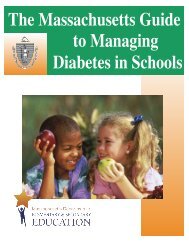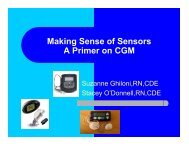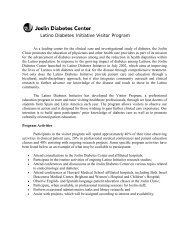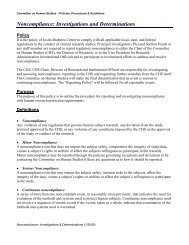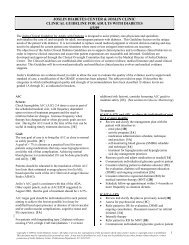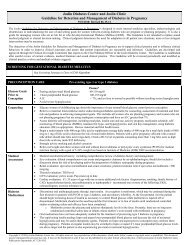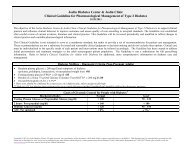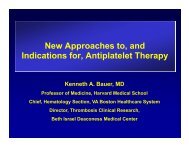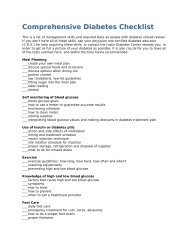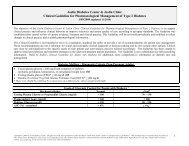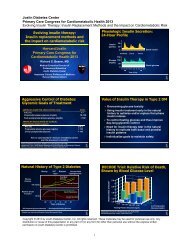Nonalcoholic Fatty Liver Disease - Dr Chopra.pdf - Joslin Diabetes ...
Nonalcoholic Fatty Liver Disease - Dr Chopra.pdf - Joslin Diabetes ...
Nonalcoholic Fatty Liver Disease - Dr Chopra.pdf - Joslin Diabetes ...
Create successful ePaper yourself
Turn your PDF publications into a flip-book with our unique Google optimized e-Paper software.
NONALCOHOLIC STEATOHEPATITIS<br />
Sanjiv <strong>Chopra</strong>, M.D., MACP<br />
Professor of Medicine<br />
Faculty Dean for Continuing Education<br />
Harvard Medical School<br />
Senior Consultant in Hepatology<br />
Beth Israel Deaconess Medical Center
Definition of NASH<br />
<strong>Nonalcoholic</strong> steatohepatitis (NASH) is<br />
the term used to describe the distinct<br />
clinical entity in which patients lack a<br />
history of significant alcohol consumption<br />
but have liver biopsy findings<br />
indistinguishable from alcoholic<br />
hepatitits.
NAFLD<br />
NAFL NASH Cirrhosis<br />
Steatosis<br />
(Macrovesicular)<br />
Steatosis<br />
Inflammation<br />
Ballooning<br />
±Mallory’s hyaline<br />
±Fibrosis<br />
Inflammation<br />
Fibrosis<br />
± Steatosis<br />
Hepatocellular<br />
carcinoma
Criteria for Dx of NASH<br />
• <strong>Liver</strong> bx shows macrovesicular fatty<br />
change with inflammation and with or<br />
without Mallory bodies, fibrosis or<br />
cirrhosis.<br />
• Convincing evidence of negligible alcohol<br />
consumption (less than 10 g/day of<br />
alcohol for women and less than 20 g/day<br />
for men).
Ultrasound showing<br />
Bright echogenic liver
<strong>Liver</strong> Ultrasound Report<br />
The liver is enlarged. It is diffusely<br />
echogenic consistent with fat infiltration<br />
of the liver. Other forms of liver disease<br />
and more advanced liver disease<br />
including early cirrhosis cannot be<br />
excluded by this study.
Biopsies<br />
macrovesicular steatosis (zone III)
lobular sinusoidal<br />
neutrophils<br />
Ballooning<br />
degeneration
Sinusoidal pericellular fibrosis, trichrome stain
NASH: <strong>Liver</strong> Histology
Cirrhosis, low power
NASH is Likely a Major Cause<br />
of Cryptogenic Cirrhosis<br />
• 74% of 70 consecutive patients with<br />
cryptogenic cirrhosis had obesity and/or<br />
diabetes<br />
• This percentage is similar to prevalence<br />
of obesity and/or diabetes noted in 50<br />
consecutive patients with NASH
Epidemiology of NAFLD<br />
• Estimate: 40 million Americans have NAFLD<br />
5 million are cirrhotic<br />
• Majority of Pts with NASH have metabolic<br />
syndrome<br />
• Over age 60 years, 40% have metabolic syndrome
NAFLD is Part of the Metabolic Syndrome<br />
Called Syndrome X<br />
Obesity<br />
Hypertriglyceridemia<br />
Hyperinsulinemia<br />
Hypertension<br />
Insulin Resistance<br />
<strong>Diabetes</strong>
Patients with NASH<br />
Normal ALT Increased ALT p.value<br />
Fibrosis Stage 22% 34%<br />
2 or greater<br />
NS<br />
Fracanzani AL, et al.<br />
Hepatology 2008:48;792
Other Conditions Associated with NASH<br />
• <strong>Dr</strong>ugs or Toxins<br />
• Abdominal Surgery<br />
• Metabolic Disorders<br />
• Miscellaneous
One disorder that is critical to exclude in<br />
young individuals is Wilson’s disease
K-F Ring
<strong>Dr</strong>ugs Associated with NASH<br />
Glucocorticoids<br />
Tamoxifen<br />
Synthetic estrogens<br />
Perhexilene maleate<br />
Amiodarone<br />
Isoniazid
Progression to Cirrhosis 10 Yr Survival<br />
Alcoholic 38 –50% 20%<br />
Hepatitis<br />
NASH 8 – 26% 60%
Clinical Features of NASH<br />
Symptoms<br />
Asymptomatic<br />
<br />
Fatigue<br />
<br />
RUQ Discomfort or Pain
Laboratory Features of NASH<br />
• ALT and AST 2 to 4 fold elevated in most<br />
patients<br />
• Alk phos mildly elevated in a third of patients<br />
• Albumin, PT, bilirubin most often normal<br />
• Serum ferritin elevated in half the patients
Patients with Suspected NASH should<br />
Undergo <strong>Liver</strong> Biopsy<br />
Pros<br />
Cons<br />
NASH is a histologic dx<br />
Small but finite risk<br />
of complications<br />
Poor correlation between lab Biopsy results may not<br />
findings and histologic severity change management<br />
Biopsy results may change Limited manpower<br />
management
Suspected NASH: Reasonable to perform liver biopsy<br />
If any of following present<br />
• Peripheral stigmata of chronic liver disease<br />
• Splenomegaly<br />
• Cytopenia<br />
• Abnormal iron studies<br />
• <strong>Diabetes</strong> and/or significant obesity in a patient over 45<br />
years of age with elevated ALT
Are there alternatives to liver biopsy?
Sampling error of liver biopsy<br />
Fibrosis area: 65%<br />
Fibrosis area: 15%<br />
Courtesy of M. Pinzani, Florence
Fibrotest (fibrosure)<br />
Alpha 2 macroglobulin, haptoglobin,<br />
gammaglobulin, GGT, total bilirubin,<br />
apolipoprotein A1<br />
The severity of disease was correctly identified in<br />
46% of patients.<br />
Fibrosure. I am not so sure!<br />
Am J Gastroenterol 2006
Fibroscan<br />
• Non-fasting<br />
• Examination time < 5 minutes<br />
• Median value of 10 successful<br />
acquisitions<br />
• Sampling error<br />
Biopsy – 1/50,000<br />
Fibroscan – 1/500<br />
Courtesy of N. Afdhal, MD
Hepatic Elastography<br />
Sampled volume: 1: 500<br />
Courtesy N. Afdhal, MD
Sampling<br />
• <strong>Liver</strong> biopsy samples only 1/50,000 th of whole liver.<br />
• Fibroscan samples 1/500 th of whole liver.
Likely Future Scenario<br />
Patients with suspected <strong>Liver</strong> <strong>Disease</strong><br />
Biomarkers and Fibroscan<br />
Low likelihood of fibrosis<br />
Grey zone<br />
High likelihood of fibrosis<br />
No liver biopsy<br />
Follow or treat<br />
<strong>Liver</strong> biopsy<br />
No liver biopsy<br />
Screen HCC, varices
Transient elastography (Fibroscan) is accurate in<br />
most patients with NAFLD. With high<br />
negative predictive value and modest positive<br />
predictive value, Fibroscan is useful as a<br />
screening test to exclude advances fibrosis.<br />
Wong V W-S, et al.<br />
Hepatology 2010; 51:454-462
Progression of NAFLD<br />
Initial Biopsy Results May Be Useful<br />
Progression to<br />
• Fat Alone 5%<br />
Cirrhosis<br />
• Ballooning Degeneration<br />
and<br />
Mallory Hyaline or Fibrosis<br />
Progression to<br />
Cirrhosis<br />
25%<br />
Gastroenterology: 1999;116:1413
Pathogenesis of NASH<br />
• Perturbation of fatty acid processing.<br />
• Insulin resistance<br />
• Lipid peroxidation and oxidative stress*<br />
* Potential oxidative stressors include:<br />
hepatic iron, intestinal bacteria, leptin and states<br />
characterized by anti-oxidant deficiencies
Pathogenesis of NAFLD/NASH<br />
The “Two Hit” Hypothesis<br />
Normal<br />
Steatosis<br />
1st “Hit”<br />
Hyperinsulinemia<br />
FFA flux<br />
FFA oxidation<br />
Triglyceride export<br />
2nd “Hit”<br />
Oxidative stress<br />
(Iron, CYP2E1)<br />
Lipid peroxidation<br />
TNFa<br />
TGFb<br />
Leptin<br />
Inflammation<br />
&<br />
Fibrosis
Prevention and Treatment of NASH<br />
• Prevention of obesity and metabolic syndrome<br />
• Treatment of metabolic syndrome<br />
• Coffee ?<br />
• Bariatric Surgery if appropriate
Pioglitazone therapy over a 12 month period<br />
in nondiabetic NASH patients resulted in<br />
improvement in biochemical, metabolic and<br />
histological parameters (including fibrosis).<br />
Aithal GP, et al.<br />
Gastroenterology 2008: 135;1176
NASH: Weight Loss is Beneficial !<br />
1. 9% or greater weight loss resulted in:<br />
• Biochemical improvement<br />
• Histologic improvement (steatosis, ballooning, inflamm n )<br />
• Improvement in Insulin resistance<br />
• Higher Adiponectin levels<br />
Harrison SA, et al.<br />
Hepatology 2009;49:80<br />
2. Following bariatric surgery, Hepatic Fibrosis improved<br />
or was reversed in 66%.<br />
Furuya CK Jr., et al.<br />
J Gastro Hepatol 2007;22:510
Vitamin E May Have Benefit<br />
• 247 Adults with NASH (without diabetes) randomly assigned to<br />
pioglitazone (30 mg. daily) Vitamin E (800 IU daily) or placebo for<br />
96 weeks*.<br />
• Vitamin E group had significant improvement in global histology<br />
scores compared with placebo (43% vs 19%).<br />
• Concerns regarding Vitamin E and increased mortality have led<br />
many Hepatologists to not recommend Vitamin E or to use 400 IU<br />
daily.<br />
* Sanyal, A, et al. Pioglitazone, vitamine E, or placebo for<br />
nonalcoholic steatohepatitis. N Engl J Med 2010
1. Who is this person and how old was he when<br />
he died?<br />
Voltaire (1694 – 1778) 83 years<br />
2. How many cups of coffee did he drink every<br />
day?<br />
50-72 !
A New Kind of Coffee Connection!
Mechanism of Protective Effect of<br />
Coffee Unknown<br />
• Caffeine, cafestol and kahweol protective in<br />
experimental studies<br />
• Antioxidant effect<br />
• Insulin sensitizing effect<br />
• Coffee drinkers have higher levels of plasma<br />
adiponectin
More than 1 Billion People in the World Have<br />
Chronic <strong>Liver</strong> <strong>Disease</strong><br />
Consuming two cups of coffee per day<br />
reduces hospitalization rate and<br />
mortality from chronic liver disease by<br />
more than 50%<br />
Ruhl CE, et al. Gastroenterology 2005;129:1928
References: Coffee and <strong>Liver</strong> <strong>Disease</strong>, 2012<br />
Sanjiv <strong>Chopra</strong>, MD, MACP<br />
1. Klatsky A, Armstrong M. Alcohol, smoking, coffee and<br />
cirrhosis. Am J Epidemiol. 1992;136:1248.<br />
2. Casiglia E, et al. Unexpected effects of coffee<br />
consumption on liver enzymes. Eur J Epidemiol.<br />
1993;9:293.<br />
3. Tverdal A, Skurveit S. Coffee intake and mortality from<br />
liver cirrhosis. Ann Epidemiol. 2003;13:419.<br />
4. Shimazu T, et al. Coffee consumption and the risk of<br />
primary liver cancer; pooled analysis of two prospective<br />
studies in Japan. Int J Cancer. 2005;10:150.
5. Ruhl CE, Everhart J. Coffee and tea consumption are<br />
associated with a lower incidence of chronic liver disease in the<br />
United States. Gastroenterology. 2005;129:1928.<br />
6. Klatsky AL, Morton C, Udaltsova N, Friedman G. Coffee,<br />
cirrhosis, and transaminase enzymes. Arch Intern Med.<br />
2006;166:1190.<br />
7. Hu G, Tuomilehto J, Pukkala E, Hakulinen T, Antikainen R,<br />
Vartiainen E, Jousilahti P. Joint effects of coffee consumption<br />
and serum gamma-glutamyltransferase on the risk of liver<br />
cancer. Hepatology. 2008;48(1):129-36.<br />
8. Larsson SC, Wolk A. Coffee consumption and risk of liver<br />
cancer: a meta-analysis. Gastroenterology. 2007;132(5):1740-5.
9. Corrao G, Zambon A, Bagnardi V, D'Amicis A, Klatsky A;<br />
Collaborative SIDECIR Group. Coffee, caffeine, and the risk of liver<br />
cirrhosis. Ann Epidemiol. 2001;11(7):458-65.<br />
10. Gallus S, Tavani A, Negri E, La Vecchia C. Does coffee protect<br />
against liver cirrhosis? Ann Epidemiol. 2002;12(3):202-5.<br />
11. Schilter B, Perrin I, Cavin C, Huggett AC. Placental glutathione S-<br />
transferase (GST-P) induction as a potential mechanism for the anticarcinogenic<br />
effect of the coffee-specific components cafestol and<br />
kahweol. Carcinogenesis. 1996;17(11):2377-84.<br />
12. Gelatti U, Covolo L, Franceschini M, Pirali F, Tagger A, Ribero ML,<br />
Trevisi P, Martelli C, Nardi G, Donato F; Brescia HCC Study Group.<br />
Coffee consumption reduces the risk of hepatocellular carcinoma<br />
independently of its aetiology: a case-control study. J Hepatol.<br />
2005;42(4):528-34.
13. Modi AA, Feld JJ, Park Y, Kleiner DE, Everhart JE, Liang TJ,<br />
Hoofnagle JH. Increased caffeine consumption is associated with reduced<br />
hepatic fibrosis. Hepatology. 2010;51(1):201-9.<br />
14. Kalthoff S, Ehmer U, Freiberg N, Manns MP, Strassburg CP. Coffee<br />
induces expression of glucuronosyltransferases by the aryl hydrocarbon<br />
receptor and Nrf2 in liver and stomach. Gastroenterology.<br />
2010;139(5):1699-710.<br />
15. Freedman ND et al. Coffee consumption is associated with response<br />
to peginterferon and ribavirin therapy in patients with chronic hepatitis C.<br />
Gastroenterology 2011; 140: 161-69.<br />
16. Molloy JW, Calcagno CJ, Williams CD, Jones FJ, Torres DM,<br />
Harrison SA. Association of coffee and caffeine consumption with fatty<br />
liver disease, nonalcoholic steatohepatitis, and degree of hepatic fibrosis.<br />
Hepatology. 2012;55(2):429-36.
Large prospective study; Coffee<br />
consumption inversely associated with<br />
total and cause-specific mortality.<br />
• Freedman, ND Ph.D., Park, Y Sc.D., Abnet, CC Ph.D., et<br />
al. Association of Coffee <strong>Dr</strong>inking with Total and<br />
Cause-Specific Mortality N Engl J Med 2012; 366:1891-<br />
1904
Kaldi the shepherd from Kaffa
“Coffee is so good, the<br />
infidels should not have<br />
exclusive use of it.”<br />
Pope Vincent III
Potential Approaches to Treatment in the Future<br />
• Will likely include combination therapy and<br />
life-style changes.<br />
• Experimental study in a rat model of NASH<br />
combining angiotensin II receptor blocker with<br />
an oral iron chelator attenuated progression.<br />
• Moderate exercise and coffee consumption<br />
likely of benefit.
Patients with Elevated Transaminases are not<br />
at Higher Risk for Statin Hepatotoxicity<br />
Mild-Moderate Severe<br />
Elevations Elevations<br />
• 1439 with normal transaminases 1.9% 0.2%<br />
prescribed a statin<br />
• 342 with elevated transaminases 4.7% 0.6 %<br />
prescribed a statin<br />
• 2245 with elevated transaminases not 6.4% 0.4%<br />
prescribed a statin<br />
Chalasani et al: Gastroenterology 2004;126
Quiz Answer True or False<br />
1. NAFLD is the most common hepatic disorder in the U.S.<br />
2. Serum ferritin is elevated in 50% of pts with NASH.<br />
3. NASH has been reported in children.<br />
4. Progression to cirrhosis occurs in 15-20% of pts.<br />
5. NASH is likely the leading cause of cryptogenic cirrhosis.
Quiz (Continued) Answer True or False<br />
6. The histologic features of NASH maybe seen in<br />
Wilson’s disease.<br />
7. Both Amiodarone and Tamoxifen can cause NASH.<br />
8. Primary hepatocellular carcinoma has been reported<br />
in patients with NASH and cirrhosis.




